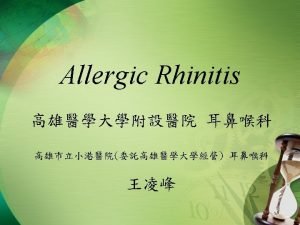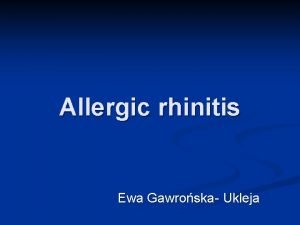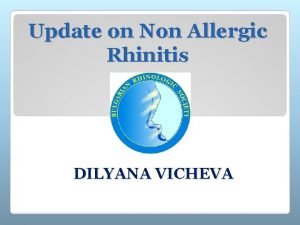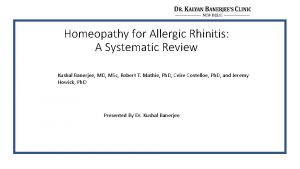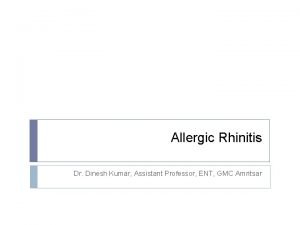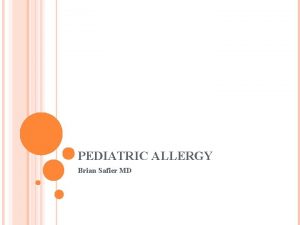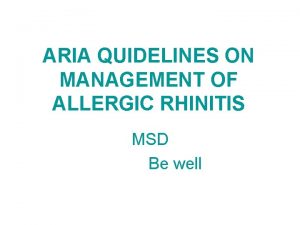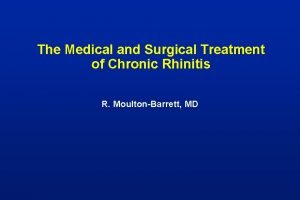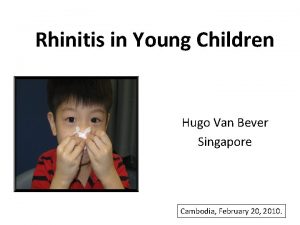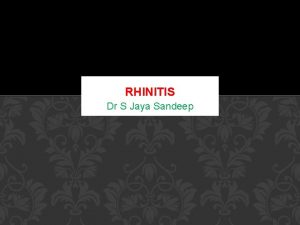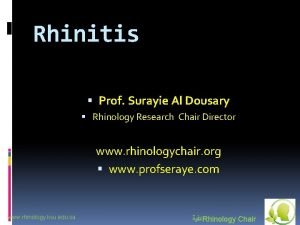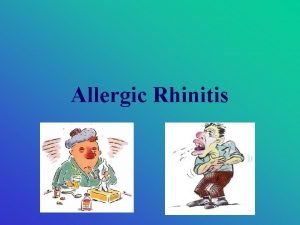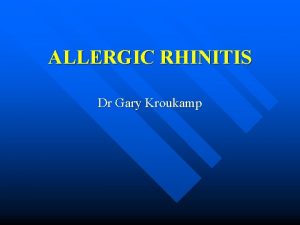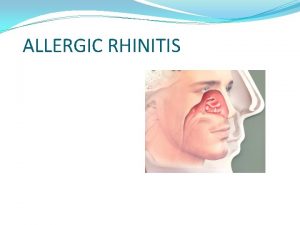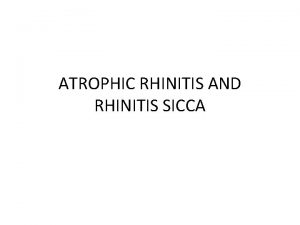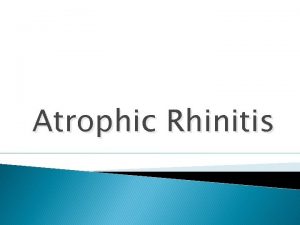Drugs for Allergic Rhinitis Cough and Colds Allergic













- Slides: 13

Drugs for Allergic Rhinitis, Cough, and Colds

Allergic Rhinitis Inflammatory disorder of the upper airway, lower airway, and eyes Symptoms Ø Ø Ø Sneezing Rhinorrhea Pruritus Nasal congestion For some people: conjunctivitis, sinusitis, and asthma

Allergic Rhinitis Seasonal and perennial Triggered by airborne allergens Allergens bind to immunoglobulin (Ig)E on mast cells Inflammatory mediators released Ø Histamine, leukotrienes, and prostaglandins

Classes of Drugs Used for Allergic Rhinitis Oral antihistamines Intranasal glucocorticoids Sympathomimetics (oral and intranasal)

Oral Antihistamines For allergic rhinitis Do not reduce nasal congestion Most effective if taken prophylactically Adverse effects are mild: sedation with first generation (much less with second generation) Anticholinergic effects Azelastine nasal spray Ø Ø Ø Only intranasal antihistamine available Benefits equivalent to oral antihistamines Metered-spray device, leaves bitter taste

Intranasal Glucocorticoids First choice—most effective for treatment and prevention of rhinitis Mild adverse effects Ø Ø Drying of nasal mucosa or sore throat Rarely, systemic effects (adrenal suppression and slowing of linear pediatric growth)

Intranasal Cromolyn Trade name: Nasal. Crom Ø Ø Extremely safe, but only moderately effective Suppresses release of histamines from mast cells Best used for prophylaxis, not for treatment Response may take 1– 2 weeks to develop

Sympathomimetics (Oral/Nasal) Reduce nasal congestion (do not reduce rhinorrhea, sneezing, or itching) Activate alpha 1 -adrenergic receptors on nasal blood vessels Adverse effects Ø Ø Rebound congestion CNS stimulation Cardiovascular effects and stroke Abuse

Sympathomimetics (Oral/Nasal) Factors in topical administration Ø Ø Should not use longer than 5 consecutive days Drops vs. sprays Phenylephrine, ephedrine, pseudoephedrine Antihistamine-sympathetic combinations Ø Ø Ø Ipratropium bromide (Atrovent) Montelukast (Singulair) Omalizumab (Xolair)

Drugs for Cough Antitussives Drugs that suppress cough Opioid antitussives • Codeine and hydrocodone Ø Nonopioid antitussives • Dextromethorphan • Diphenhydramine Ø Ø

Common Cold Acute upper respiratory viral infection Rhinorrhea, nasal congestion, cough, sneeze, sore throat, headache, hoarseness, malaise, myalgia Fever common in kids, rare in adults Self-limited and usually benign No cure; just treatment of symptoms

OTC Cold Remedies Combination cold remedies usually contain two or more of the following: Ø Ø Ø Nasal decongestant Antitussive Analgesic Antihistamine (for cholinergic actions) Caffeine (to offset effect of antihistamine) OTC = over-the-counter.

Pediatric OTC Cold Remedies Use with caution in young children No proof of efficacy or safety, but proof of harm Avoid OTC cold remedies in children younger than 2 years of age Ø Use only products labeled for pediatric use Ø Consult a healthcare professional before giving to a child Ø Read all product safety information before dosing Ø Use the measuring device provided with the product Ø Discontinue the medicine and seek professional care if the child’s condition worsens Ø Ø
 Management of allergic rhinitis
Management of allergic rhinitis Clarytyna
Clarytyna Types of allergic rhinitis
Types of allergic rhinitis Rhinitis medicamentosa
Rhinitis medicamentosa Moderate persistent asthma
Moderate persistent asthma Homeopathy for allergic rhinitis: a systematic review
Homeopathy for allergic rhinitis: a systematic review Allergic rhinitis treatment guidelines
Allergic rhinitis treatment guidelines Allergic crease adalah
Allergic crease adalah Aria management
Aria management Pregnancy rhinitis treatment
Pregnancy rhinitis treatment Vidian nerve cryotherapy
Vidian nerve cryotherapy Rhinitis in children
Rhinitis in children Primary atrophic rhinitis
Primary atrophic rhinitis Primary atrophic rhinitis
Primary atrophic rhinitis
